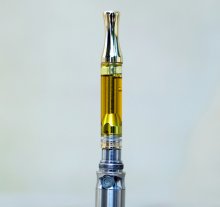
16 Oct Resources: Vaping Related Lung Injury
VAPING–RELATED LUNG INJURIES
The CDC (Centers for Disease Control and Prevention) released a report on October 4th highlighting some facts about the recent outbreak of lung injuries related to vaping. The spate of hospitalizations appears to have started in July of 2019. As of October 1, 2019, there were 1,080 reported cases matching the CDC criteria and 18 deaths. Those afflicted are typically male and in their early twenties. No single cause has been associated with all reports. Only 578 patients (about half) reported on what they had vaped in the 3 months prior to symptom onset. Of these, 78% reported using THC-containing products, and 58% reported using nicotine-containing products. Many reported using both.
There has been enormous speculation about the possible causes of these injuries. Blame and attention has tended to focus on flavoring agents and thinning and thickening additives, particularly vitamin E acetate – additives that Project CBD has been warning about for years. Others have speculated that synthetic cannabinoids may be playing a role. Several state health departments have noted that injuries seem to correlate to THC vape cartridges that had been illegally manufactured and purchased in the “black market.”
CDC CRITERIA FOR CONFIRMED & PROBABLE CASES OF VAPING–RELATED LUNG INJURY
According to the CDC, a confirmed case of Vaping-Related Lung Injury is defined as an individual that: (i) has vaped within the past 90 days, (ii) has pulmonary infiltrates which appear as ground-glass opacities on a CT scan, and (iii) has no infection, heart condition, or other disease that could explain respiratory distress. If a lung infection has not been fully ruled out, vaping is assumed to be the probable cause. Given the inclusiveness of this criteria, it’s quite likely that multiple causes are contributing to the hospitalizations and deaths.
SCIENTIFIC RESOURCES FOR VAPING–RELATED LUNG INJURIES
While hundreds of scientists are now urgently working to figure out the cause of these injuries, there are clinical case reports of these sorts of injuries going back to 2011. Below is a sampling of pertinent case articles and studies. We will keep you posted as new research emerges.
General
Flavoring & Diluting Agents
Pneumonitis
Lipoid Pneumonia
- Imaging of Vaping-Associated Lung Disease, New England Journal of Medicine, October 10, 2019
- Pulmonary Lipid-Laden Macrophages and Vaping, New England Journal of Medicine, October 10, 2019
- Vaping-Associated Acute Respiratory Failure Due to Acute Lipoid Pneumonia., Lung, October 3, 2019
- Outbreak of Electronic-Cigarette–Associated Acute Lipoid Pneumonia — North Carolina, July–August 2019, Centers for Disease Control and Prevention, September 13, 2019
- Respiratory failure caused by lipoid pneumonia from vaping e-cigarettes. BMJ Case Reports, 2018


Sorry, the comment form is closed at this time.